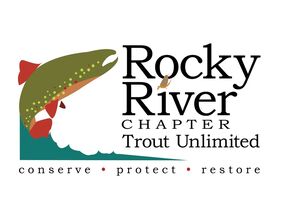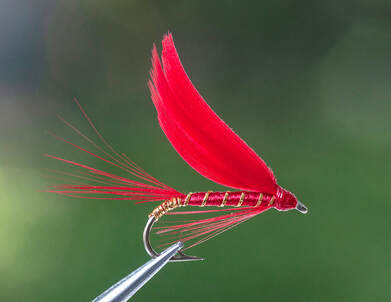Fly of the Month 02.19
During the winter, most of the catching opportunity is underwater and the choices for the angler are wet flies, soft hackle flies, nymphs, streamers or attractor patterns such as an egg, egg cluster, San Juan worm, Y2K, Estes’ Mop Fly or a Squiggly-Wiggly.
As winter days become warmer and spring is around the corner, choose a wet fly to attract hungry trout that are simply not finding enough food. Wet fly patterns are either intended to imitate an insect rising in the water column or an attractor in the water column that gets a hungry trout’s attention. Top of the list is a pheasant tail soft hackle or any one of many colorful, attractive wet flies. Ray Bergman’s Trout is an encyclopedia of over three hundred wet fly patterns. On our list to try next is an Ibis, a wet fly so named based on the bird that provided the original feathers for the fly pattern. Modern dyed-feather substitutions now protect the Ibis.
Scarlet Ibis and White Ibis Wet Fly Group
The Scarlet Ibis or Red Ibis is named based on the bird whose feathers go into the tying. When referring to this pattern the word “scarlet” should be used. There is also a white ibis bird and White Ibis fly as well.
The Silver Ibis or Tinseled Ibis, as it is sometimes called, is so named because the body is silver instead of gold-ribbed red wool. The Split Ibis has wings of both scarlet and white ibis feathers. The following table provides an overview of the variety of Scarlet Ibis and White Ibis wet fly patterns:
Name Body Hackle Wing Tail Rib
Scarlet Ibis scarlet floss scarlet scarlet scarlet gold
Silver Ibis silver tinsel scarlet scarlet scarlet -
White Ibis white floss scarlet scarlet scarlet silver
Yellow Ibis yellow floss scarlet scarlet scarlet gold
Guinea Ibis yellow floss scarlet scarlet guinea silver
Hackle Ibis white floss scarlet - - silver
Split Ibis silver tinsel scarlet scarlet & white1 scarlet & white -
Gold Ibis gold tinsel scarlet & yellow white2 scarlet & white -
White Shoulder Ibis scarlet floss scarlet & white scarlet3 scarlet -
Scarlet & White Ibis scarlet & white4 scarlet scarlet & white scarlet & white gold
1 Split scarlet with white between
2 With scarlet stripes up the sides
3 With white stripes up the sides
4 Upper half white floss, lower half scarlet floss
The Yellow Ibis is named because the body is gold-ribbed yellow wool. The Guinea Ibis is the like the Yellow Ibis except the body is silver-ribbed yellow wool with a Guinea tail. The Hackle Ibis has a silver-ribbed white wool body but no wing or tail much like other soft hackle fly patterns. The Gold Ibis, White Shoulder Ibis and Scarlet & White Ibis each have much more variation from the original Scarlet Ibis or White Ibis a viewed in the table above.
Fish any of the Ibis wet fly patterns using the traditional wet fly method of casting the fly upstream, allow the fly to naturally drift and sink, then give the fly a tug, then slack a few times as the downstream drift continues. Finally, allow the wet fly to tail-out and then retrieve upstream with a tug, then slack motion until fully retrieved and ready to repeat the presentation cycle with a change of the drift lane.
The Ibis Wet Fly Group:
Scarlet Ibis, White Ibis
Silver Ibis (alias Tinseled Ibis)
Yellow Ibis, Gold Ibis
Guinea Ibis
Hackle Ibis
Split Ibis, White Shoulder Ibis, Scarlet & White Ibis
Fly of the Month 02.19
Tom Adams and Alen Baker
References:
Smedley, Harold Hinsdill. Fly Patterns and Their Origins, 1944
Bergman, Ray. Trout
Ibis
Hook : Streamer, Tiemco 5263 or equivalent size 8,10,12,14
Thread : UTC 70 Red
Tail : Red Saddle barbs
Abdomen: Red floss with French gold tinsel rib
Wing : Red goose shoulder
Throat : Red Saddle barbs
Directions :
During the winter, most of the catching opportunity is underwater and the choices for the angler are wet flies, soft hackle flies, nymphs, streamers or attractor patterns such as an egg, egg cluster, San Juan worm, Y2K, Estes’ Mop Fly or a Squiggly-Wiggly.
As winter days become warmer and spring is around the corner, choose a wet fly to attract hungry trout that are simply not finding enough food. Wet fly patterns are either intended to imitate an insect rising in the water column or an attractor in the water column that gets a hungry trout’s attention. Top of the list is a pheasant tail soft hackle or any one of many colorful, attractive wet flies. Ray Bergman’s Trout is an encyclopedia of over three hundred wet fly patterns. On our list to try next is an Ibis, a wet fly so named based on the bird that provided the original feathers for the fly pattern. Modern dyed-feather substitutions now protect the Ibis.
Scarlet Ibis and White Ibis Wet Fly Group
The Scarlet Ibis or Red Ibis is named based on the bird whose feathers go into the tying. When referring to this pattern the word “scarlet” should be used. There is also a white ibis bird and White Ibis fly as well.
The Silver Ibis or Tinseled Ibis, as it is sometimes called, is so named because the body is silver instead of gold-ribbed red wool. The Split Ibis has wings of both scarlet and white ibis feathers. The following table provides an overview of the variety of Scarlet Ibis and White Ibis wet fly patterns:
Name Body Hackle Wing Tail Rib
Scarlet Ibis scarlet floss scarlet scarlet scarlet gold
Silver Ibis silver tinsel scarlet scarlet scarlet -
White Ibis white floss scarlet scarlet scarlet silver
Yellow Ibis yellow floss scarlet scarlet scarlet gold
Guinea Ibis yellow floss scarlet scarlet guinea silver
Hackle Ibis white floss scarlet - - silver
Split Ibis silver tinsel scarlet scarlet & white1 scarlet & white -
Gold Ibis gold tinsel scarlet & yellow white2 scarlet & white -
White Shoulder Ibis scarlet floss scarlet & white scarlet3 scarlet -
Scarlet & White Ibis scarlet & white4 scarlet scarlet & white scarlet & white gold
1 Split scarlet with white between
2 With scarlet stripes up the sides
3 With white stripes up the sides
4 Upper half white floss, lower half scarlet floss
The Yellow Ibis is named because the body is gold-ribbed yellow wool. The Guinea Ibis is the like the Yellow Ibis except the body is silver-ribbed yellow wool with a Guinea tail. The Hackle Ibis has a silver-ribbed white wool body but no wing or tail much like other soft hackle fly patterns. The Gold Ibis, White Shoulder Ibis and Scarlet & White Ibis each have much more variation from the original Scarlet Ibis or White Ibis a viewed in the table above.
Fish any of the Ibis wet fly patterns using the traditional wet fly method of casting the fly upstream, allow the fly to naturally drift and sink, then give the fly a tug, then slack a few times as the downstream drift continues. Finally, allow the wet fly to tail-out and then retrieve upstream with a tug, then slack motion until fully retrieved and ready to repeat the presentation cycle with a change of the drift lane.
The Ibis Wet Fly Group:
Scarlet Ibis, White Ibis
Silver Ibis (alias Tinseled Ibis)
Yellow Ibis, Gold Ibis
Guinea Ibis
Hackle Ibis
Split Ibis, White Shoulder Ibis, Scarlet & White Ibis
Fly of the Month 02.19
Tom Adams and Alen Baker
References:
Smedley, Harold Hinsdill. Fly Patterns and Their Origins, 1944
Bergman, Ray. Trout
Ibis
Hook : Streamer, Tiemco 5263 or equivalent size 8,10,12,14
Thread : UTC 70 Red
Tail : Red Saddle barbs
Abdomen: Red floss with French gold tinsel rib
Wing : Red goose shoulder
Throat : Red Saddle barbs
Directions :
- Mount the hook in the vise after debarbing
- Start thread wraps at the hook eye and take back toward the bend four eye lengths and let the bobbin hang
- Select a four inch piece of French gold tinsel and tie in. Make open wraps of thread will keeping the tinsel on top of the hook shank to the hook bend. Secure with two or three wraps of thread. Make four to six turns of tinsel, starting about half way down the bend and stop at the bend. Secure with two thread wraps and let the bobbin hang.
- Select a dozen or so red saddle barbs and after aligning the tips strip or cut away from the stem. Tie in on top of the hook shank with the feather covering two thirds of the shank. Make touching turns to cover the feather evenly and stop at three eye lengths back from the eye. Let the bobbin hang.
- Select a six to eight inch piece of red floss and tie in. Make even open wraps of thread to the point the tail is tied in while maintaining the floss on top of the hook shank. Secure with two wraps and advance the thread to three eye lengths from the eye and let the bobbin hang. Alternately, at this time, if you have a rotating vise, you can make a quick whip finish and move the thread to a bobbin rest. Doing that allows the vise to rotate to wrap the floss. Wrap the floss forward in slightly overlapping turns to build a tapered body and secure at the three eye lengths mark. Trim the waste and let the bobbin hang.
- Begin open, even turns of French tinsel to make ribbing to the thread and secure. Trim waste and let the bobbin hang.
- Select six or eight barbs of red hackle and after making the tips even, strip or cut from the stem. Tie in under the hook shank with the length about touching the hook point. Trim waste and let the bobbin hang.
- Select two red goose shoulder slips from matching feathers, making sure they come from approximately the same spot of the two feathers. Align the tips with the natural curves facing away form each other and concave side out. Secure the two slips at the same time on top of the hook shank (immediately in front of the floss), first with a soft wrap and then with two wraps for security. Check the position and if you are happy, complete the tie in with several more wraps.
- Form a small tapered head with thread, whip finish and coat with head cement.

